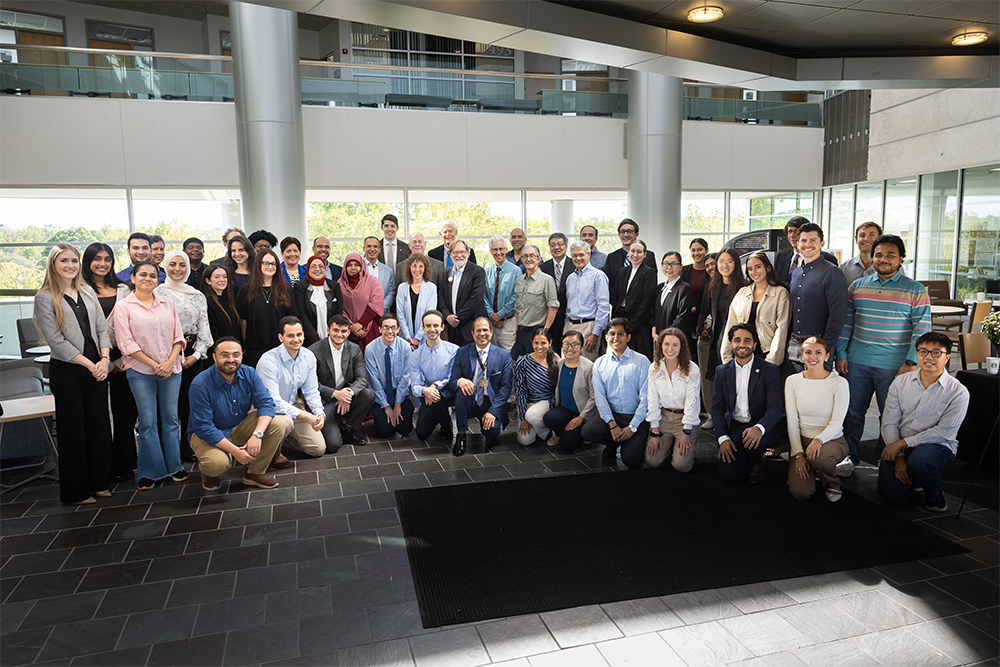For the third consecutive year, the Eye Research Retreat was held at Oakland University to showcase research and advancements in the field of ophthalmology — and serve as inspiration to continue the work.
The event was hosted Sept. 20 by the Oakland University William Beaumont School of Medicine (OUWB) Eye Research Center (ERC) in collaboration with the Oakland University Eye Research Institute (ERI).
The ERC at OUWB was founded in 2021 with a mission of performing basic and clinical research to prevent and treat eye diseases. The institution prides itself on its quality collaborative work with the OU ERI, OUWB Neuroscience program, the Department of Ophthalmology, Population Health Informatics, and the OU Department of Biological Sciences.
Established in 1968 by V. Everett Kinsey, M.D., and Venkat N. Reddy, M.D., the ERI originated as a small 10,000-square-foot building funded by the National Institutes of Health (NIH) Construction Grant. In 1984, the institute received a Core Vision grant from the National Eye Institute. Distinguished Professor Emeritus of Biomedical Sciences Frank Giblin, Ph.D. was director until 2021; Mohamed Al-Shabrawey, M.D., Ph.D., took over afterward, and is director of both the ERI and the ERC.
Each year, the retreat offers several informational sessions that showcase eye research done at Oakland University, allows experts to present updates in the field, and provides a space for building connections.
“I am so proud that the Eye Research Center and the Institute provide great platforms that enrich growth, collaboration, and restoration for our student residents and fellows,” said Al-Shabrawey. “This collectively ensures that we accomplish our goals for our training. I am deeply honored and proud that our annual retreat continues to serve as a true platform for our trainees but also is a great opportunity to engage with university leaders.”
To start the morning, a community of scholars, researchers, clinicians, and leaders gathered as Amany Tawfik, M.D., chair of the retreat committee, welcomed attendees and introduced Oakland University President Ora Hirsch Pescovitz, M.D. Pescovitz said she was acutely aware of the dedication within these programs before being employed by the university.
“I had heard of what was being done here in the ERI and in ophthalmology research, because this institute and the eye research discoveries that were already taking place here by some of your predecessors were already world-renowned … it was already clear to me that what was happening here was truly cutting edge…(and) part of what makes Oakland University so extraordinary,” said Pescovitz.
George Williams, M.D., professor and chair of the Department of Ophthalmology, OUWB, outlined some key changes to the direction of research per the U.S. Department of Health and Human Services 2026 budget. The National Eye Institute (NEI) started in 1968 with a primary focus on visual science, and now the proposal is to integrate the NEI into a new national institute of neuroscience and brain research. Furthermore, a proposal remains on the table to cut 40% from the NIH’s medical research budget.
He also talked about OUWB’s success in ophthalmology.
“We have one of the highest success rates for matching our medical students into ophthalmology, which is, as you all know, a very competitive residency. We have seen our graduates go on to training in outstanding institutions, not only ours, but throughout the country,” he said.
He highlighted the success of Adam Weiner, M.D., OUWB ’15. Weiner completed residency at Corewell Health William Beaumont University Hospital (WBUH) in Royal Oak before completing a two-year vitriol retinal fellowship with a specialty in ocular oncology. Today, he is an ocular oncologist at WBUH and is now an assistant professor at OUWB and serving as a PRISM mentor for the Class of 2029, and “is doing a great job,” said Williams.
The keynote speaker was David Berson, Ph.D., chair, Department of Neuroscience, and Sidney A. Fox and Dorothea Doctors Fox Professor of Ophthalmology and Visual Science, Brown University. Berson’s presentation was called “Understanding Vision through Retinal Connectomics”.
Among other things, Berson spoke about the utilization of artificial intelligence (AI), which aided him in his research. Afterwards, he said he also sought to inspire younger researchers.
“I want to underscore what others have said here,” he said. “This is a tough time for scientists, especially for young scientists. Don’t lose heart, hang in there. Scientists are first and foremost adaptive. If things don’t go well in the lab, you figure a way to work around it. This is a community, and we don’t let our young people fall by the wayside. Stick with it.”
Oral presentations then came from Nadia Abdelhady, pre-medical student, University of Michigan, American Heart (AHA) SUPER program, who presented “Nutritional Regulation of Ferroptosis: The Role of B Vitamin Deficiency in Age-Related Macular Degeneration” (Mentor: Amany Tawfik, M.D.); Rudrick Casey Boucher, Ph.D., student, Oakland University, who presented “Scaffolding vision: Prph2 and Rom1 Shape Photoreceptor Outer Segment Structure (Mentor: Andrew Goldberg, Ph.D.); and Muhammad Nazmul Haque, Ph.D., postdoctoral research fellow, OU, who presented “A Novel Strategy to Enhance the Therapeutic Effect of AT1 Blockade in Diabetic Retinopathy” (Mentor: Mohamed Al-Shabrawey, Ph.D.)
An additional round of presentations were delivered by Adam Neuhouser, M.D., occuloplastic and orbital surgery fellow, who presented “Corneal Neurotization: Turning Basic Science into a Successful Surgical Technique”; WenQiu Wang, M.D, Ph.D., postdoctoral research fellow, OU, who presented “A unique type of retinal amacrine cells: development and function” (Mentor: Dao-Qi Zhang, Ph.D.); and Mathew Seidel, undergraduate student, Oakland University, who presented “Sphingomyelin and Acid Sphingomyelinase in Experimental Glaucoma” (Mentor: Michael Risner, Ph.D.).
In addition to the oral presentations there were 30 poster presentations by different levels of mentees (undergraduate, medical and graduate students, residents and postdoctoral fellows.)
Al-Shabrawey and Tawfik closed the retreat in gratitude and noted that the event highlights the partnership between clinical and basic science. They noted that raising awareness about the duties that exist both on the clinical side and in research is always a key component of the retreat.
“At the end of the day, we are committed to achieving our mission to train the next generation and enrich our scientific environment within OUWB and OU,” said Al-Shabrawey.
“Alone, we can do so little. Together, we can do so much,” added Tawfik.
To request an interview, visit the OUWB Communications & Marketing webpage.
This work is licensed under a Creative Commons Attribution-NonCommercial 4.0 International License.








